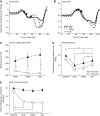Impaired reactive stepping adjustments in older adults
- PMID: 19351694
- PMCID: PMC2691798
- DOI: 10.1093/gerona/glp027
Impaired reactive stepping adjustments in older adults
Abstract
Background: The ability to redirect the path of the foot during walking is critical for responding to perturbations and maintaining upright stability. The purpose of the current study was to compare mechanisms of reactive stepping adjustments in young versus older adults when responding to an unexpected perturbation during voluntary step initiation.
Methods: We tested 13 healthy community-dwelling older adults and an equal number of young control participants performing stepping movements onto a visual target on the floor. In some trials, perturbations were introduced by unexpectedly shifting the target, at various time points, from its usual location to a new location 20 cm to the right. We measured ground reaction forces under the supporting leg and three-dimensional kinematics of the stepping leg in baseline and target shift trials.
Results: During target shift trials, that is, when reactive adjustments were required, older adults demonstrated the following: delayed responses in modifying the lateral propulsive forces under the supporting foot, reduced rates of lateral force production, delayed responses in modifying the stepping foot trajectory, and prolonged movement execution times.
Conclusions: The current study quantitatively distinguishes between healthy older and young adults in generating reactive stepping adjustments to an unpredictable shift of a visual target. The decreased capability for rapidly planning and executing an effective voluntary step modification could reveal one potential cause for the increased risk of falls in the older population.
Figures





Similar articles
-
Lateral step initiation behavior in older adults.Gait Posture. 2014 Feb;39(2):799-803. doi: 10.1016/j.gaitpost.2013.10.021. Epub 2013 Nov 5. Gait Posture. 2014. PMID: 24295896 Free PMC article.
-
Evidence for age-related decline in visuomotor function and reactive stepping adjustments.Gait Posture. 2012 Jul;36(3):477-81. doi: 10.1016/j.gaitpost.2012.04.009. Epub 2012 May 19. Gait Posture. 2012. PMID: 22609043
-
Aging effect on step adjustments and stability control in visually perturbed gait initiation.Gait Posture. 2017 Oct;58:268-273. doi: 10.1016/j.gaitpost.2017.08.013. Epub 2017 Aug 18. Gait Posture. 2017. PMID: 28837917
-
External postural perturbations induce multiple anticipatory postural adjustments when subjects cannot pre-select their stepping foot.Exp Brain Res. 2007 May;179(1):29-42. doi: 10.1007/s00221-006-0763-5. Epub 2006 Nov 8. Exp Brain Res. 2007. PMID: 17091288
-
Effect of competing attentional demands on perturbation-evoked stepping reactions and associated gaze behavior in young and older adults.J Gerontol A Biol Sci Med Sci. 2008 Dec;63(12):1370-9. doi: 10.1093/gerona/63.12.1370. J Gerontol A Biol Sci Med Sci. 2008. PMID: 19126851 Clinical Trial.
Cited by
-
Quick foot placement adjustments during gait: direction matters.Exp Brain Res. 2015 Dec;233(12):3349-57. doi: 10.1007/s00221-015-4401-y. Epub 2015 Aug 11. Exp Brain Res. 2015. PMID: 26259749
-
Anodal Transcranial Direct Current Stimulation Enhances Retention of Visuomotor Stepping Skills in Healthy Adults.Front Hum Neurosci. 2020 Jun 26;14:251. doi: 10.3389/fnhum.2020.00251. eCollection 2020. Front Hum Neurosci. 2020. PMID: 32676018 Free PMC article.
-
Can telling older adults where to look reduce falls? Evidence for a causal link between inappropriate visual sampling and suboptimal stepping performance.Exp Brain Res. 2010 Jul;204(1):103-13. doi: 10.1007/s00221-010-2300-9. Epub 2010 May 29. Exp Brain Res. 2010. PMID: 20512484 Clinical Trial.
-
Effects of aging and target location on reaction time and accuracy of lateral precision stepping during walking.J Biomech. 2020 May 7;104:109710. doi: 10.1016/j.jbiomech.2020.109710. Epub 2020 Feb 28. J Biomech. 2020. PMID: 32156445 Free PMC article.
-
Effects of aging and dual tasking on step adjustments to perturbations in visually cued walking.Exp Brain Res. 2015 Dec;233(12):3467-74. doi: 10.1007/s00221-015-4407-5. Epub 2015 Aug 23. Exp Brain Res. 2015. PMID: 26298043 Free PMC article.
References
-
- Rubenstein L. Falls in older people: epidemiology, risk factors and strategies for prevention. Age Aging. 2006;35:ii37–ii41. - PubMed
-
- Ashley MJ, Gryfe CI, Amies A. A longitudinal study of falls in an elderly population II. Some circumstances of falling. Age Ageing. 1977;6:211–220. - PubMed
-
- Horak FB, Macpherson JM. Postural orientation and equilibrium. In: Shepard J, Rowell L, editors. Handbook of Physiology. New York, NY: Oxford University Press; 1996. pp. 255–292.
-
- Horak FB, Henry SM, Shumway-Cook A. Postural perturbations: new insights for treatment of balance disorders. Phys Ther. 1997;77:517–533. - PubMed
-
- Massion J. Movement, posture and equilibrium: interaction and coordination. Prog Neurobiol. 1992;38:35–56. - PubMed
Publication types
MeSH terms
Grants and funding
LinkOut - more resources
Full Text Sources
Medical

